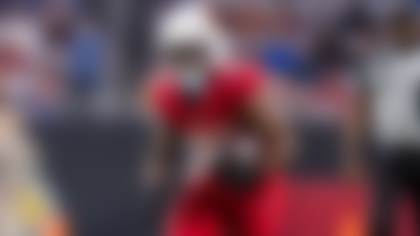The first QB domino, in an offseason that seems likely to have many signal callers on the move, has fallen. Matthew Stafford has been traded to the Los Angeles Rams in exchange for Jared Goff and draft picks. If you're like me at all, your brain instantly starts wondering the impact this trade will have on not only the two QBs, but their new teams' fantasy pieces as well. Luckily for you, we are here to break it down!
What it means for Stafford and the Rams
The Rams were an offensive powerhouse in their first couple of seasons with Sean McVay as the head coach, but in the past two years, especially in 2020, they had to rely more on their defense to get them into the playoffs. It was just a couple years ago that the Rams made the Super Bowl on the back of their high-powered offense. Since then the offensive line has deteriorated, and Goff showed that he struggles under pressure. That right there should be an upgrade for the Rams this season, as Stafford has played better under pressure. Just in 2020, Stafford threw for 927 yards and eight touchdowns and two interceptions with a 46.1 completion percentage and 13.5 aDOT, per PFF. Those numbers for Goff this past season were just 613 yards, four TDs, seven INTs, 41.8% and an 8.3 aDOT. So not only did Stafford put up better raw numbers under pressure, but he completed a higher rate of passes, all while taking more deep shots and turning it over less. And before you say anything about volume matters, Goff had more attempts under pressure than Stafford. That right there is one key reason this move should upgrade the Rams' offense.
The other is that Stafford seems to be a better fit for the offense McVay wants to run. Last season the Rams ran play action on 33% of their plays, the fifth-most in the NFL, compared to just 24% for the Lions (20th). Stafford is better suited to take advantage of those play-action calls and turn them into big gains through the air. Last season on play-action passes, Stafford had a 60.5 completion percentage, averaged 8.6 yards per attempt, including 11.1 air yards per throw with 58% of the yards he picked up coming through the air and not after the catch. Goff completed 66% of his throws, with 7.8 yards per attempt, 6.7 air yards per throw and just 42% of the yardage coming through the air. To break that down, it means that Goff was simply throwing the ball closer to the line of scrimmage and relying on his weapons to pick up yardage after the catch, while Stafford was more aggressive and taking shots down the field. That bodes well for Robert Woods, who led the Rams in targets, catches, yards and TDs on play-action passes last season. But play action is not the only aspect where Stafford has shown to be the better downfield passer. On all passes of 20-plus air yards in 2020 Stafford had a higher completion percentage (37.3-28.2), averaged more yards per attempt (13.4 to 9.4) and put up better raw numbers (791 yards, 6 TD to 366 yards, 3 TD). He is just an all-around better deep ball passer and he has shown that he will be more aggressive throwing the ball downfield. I expect Stafford to go off the board somewhere between QB10 and 12, but I would not take him over the duel-threat QBs that can give you vital points with their legs (that means behind Jalen Hurts if he is the starter in Philly).
Lastly, these two also have shown different tendencies as a passer. Last season Stafford averaged 8.7 air yards per attempt and threw 53 percent of his passes to receivers, 22 percent to tight ends and 22 percent to running backs. While Goff averaged 6.5 air yards per attempt and threw 62 percent of his passes to receivers, 21 percent to tight ends and 12 percent to RBs. Personnel matters there, but in their careers, Stafford has averaged 22 percent of throws to RBs, while Goff is at 14 percent. To me, this is a huge upgrade for Cam Akers, who showed at the end of the season and the playoffs that he can clearly be a very effective runner in this league. But now if he is going to see the ball thrown his way nearly 10 percent more often? That is huge for PPR leagues, as an RB target is roughly three times as valuable as an RB carry. McVay showed in the playoffs that he trusts Akers to be the lead back and while I would not say to expect prime Todd Gurley results, we do have a very successful track record of McVay working with his lead back. Akers is going to go off draft boards as an RB1 come the summer, if not sooner.
This also has a great impact on the Rams receivers. We already know that Woods is set up to be the biggest benefactor on play action passes. But if the volume remains the same for Woods -- who has seen at least 129 targets in his last three seasons -- he should be an improved fantasy asset. Seeing that volume, he has averaged between 15.3 and 16.6 fantasy PPG. But last season he was boosted by a career-high eight touchdowns, which helped make up for a career-low 7.5 air yards per target. It is easier to gain fantasy points in chunks when you are being used downfield more, as you can gain yards in chunks and not have to hope he breaks a tackle or finds a seam to get meaningful yards. The same can be said for Cooper Kupp, who put up his worst fantasy season since his rookie year. Kupp only scored three touchdowns, which obviously hurts, but what also didn't help was a career-low 6.7 air yards per target. Being used close to the line of scrimmage helped turn Kupp from a top-five WR in 2019, to a boring, low-upside WR3 in 2020. In fact, he had 35% of his targets and fantasy points in just three games last season. I am expecting more consistent production this season with Stafford at the helm. While I have a slight lean toward Woods, both should be valued as WR2 with the upside to make the jump to be a WR1. We will have to monitor the reports out of Rams camp all summer to see if there is one that has a stronger rapport with Stafford. Van Jefferson did not get utilized much as a rookie, but with a QB willing to throw the ball downfield, his blazing speed can be better utilized. With Josh Reynolds a free agent, Jefferson is a sleeper to take over the old Brandin Cooks role in this offense.
While I will not be advocating to draft Tyler Higbee or Gerald Everett this season, I do think both have higher upside with Stafford, as it's an upgrade for the entire offense. They can work their way to becoming a waiver wire or streaming option in 2021.
What it means for Goff and the Lions
While this move means a lot of good for Stafford, what about for Goff and the Lions? The Lions clearly made this move with an eye towards the future, but for fantasy we need to know how this will impact the immediate future. The biggest factor for fantasy on the Lions is running back D'Andre Swift. Swift started off 2020 in a committee with Adrian Peterson and Kerryon Johnson, earned his way to the starting job and then was forced to miss time due to an injury, yet he was still a top-20 fantasy RB in total points and fantasy PPG. He averaged 3.5 catches per game and put up 357 receiving yards, both of which were in the top 11 among RBs. He also scored 10 touchdowns in just 13 games, the most by a Lions rookie since Barry Sanders. Not bad company to be in. But, given the moves this offseason, I have much higher expectations for Swift in his second season. The Lions have hired former Chargers HC Anthony Lynn as their offensive coordinator. Fun fact about Lynn, he's a former running back and RBs coach. He also has had 26% of passes and 41% of the touches go to running backs during his four-year tenure with the Chargers. I expect a lot of volume for Swift under Lynn and have him ranked as an RB1, although Akers or Swift will be an interesting debate all summer long.
As for the passing game, there are a lot of unknowns as their top three receivers in 2020, Kenny Golladay, Marvin Jones and Danny Amendola are all free agents now. We will have to see what the Lions do here. But barring all three returning, or the Lions bringing in multiple other receivers, you must feel good about T.J. Hockenson. The former Iowa tight end finished in the top 10 amongst tight ends in fantasy points, fantasy PPG, targets per game, target share, 10-plus fantasy performances and receiving yards per game. He does not come with the upside of the elite tight ends, but he is a safe fallback option after the big three at the position (Kelce, Waller, Kittle) are selected. Less competition for targets would only cement him in the second tier of tight ends heading into 2021.
As for Goff, I recently said on the NFL Fantasy podcast that there was a zero percent chance he would be my starting QB in any league heading into 2021. And sadly, that was when he was still a Ram! I spent a lot of time discussing why I think Stafford is an upgrade for the Rams, but that's not why I am fading Goff. He is now in a situation with a first-time head coach and new offensive coordinator. Perhaps the Campbell-Lynn combination can work wonders in Detroit, but I am much less confident in them then I am in a proven commodity like McVay. Also, while the Lions can still surround Goff with talent, as of now it is an obvious downgrade from the weapons he had around him in Los Angeles. Goff's passing yards, touchdowns, and fantasy points have all decreased in each season since 2018. He also does not give you much with his legs, as he has once rushed for over 100 yards and last year was his first season with more than two rushing touchdowns. He was already outside the top-15 QBs for me heading into 2021, but with the move to Detroit, I am valuing him as a low-end QB2 with significantly less upside.
Let me know your thoughts on the trade on Twitter and Instagram @MichaelFFlorio.












